A Wader Spectacular tour today. It was cloudy most of the day, but we didn’t really get the rain we had been forecast earlier in the week, just a few spits and spots late morning or early afternoon, barely enough to notice.
After an early start, we made our way across towards the Wash in good time to catch the rising tide. On our way, a Red Kite circled over beside the road and a couple of Red-legged Partridges seemed to be hell bent on destruction, playing chicken in the road.
Making our way down to the edge of the Wash, we stopped first as soon as we got up on the seawall. The tide was coming in but there was still a lot of exposed mud. The waders were gathering, but they were still quite spread out, a large black slick of Oystercatchers and, much further out, an enormous mass of Knot and others.
On the tip of the mud on the far side of the channel, we could see a gathering of terns, large Sandwich Terns with a yellow-tipped black bill, medium-sized Common Terns with a black-tipped orange-red bill and a few much smaller Little Terns, with a black-tipped yellow-bill and white forehead. But the tide was coming in fast and they couldn’t really settle, being continually pushed in by the rising water. Several Shelducks were feeding in the shallow water, just off the mud and two or three Little Egrets were already pushed off by the rising tide and flew over the seawall to the pits.
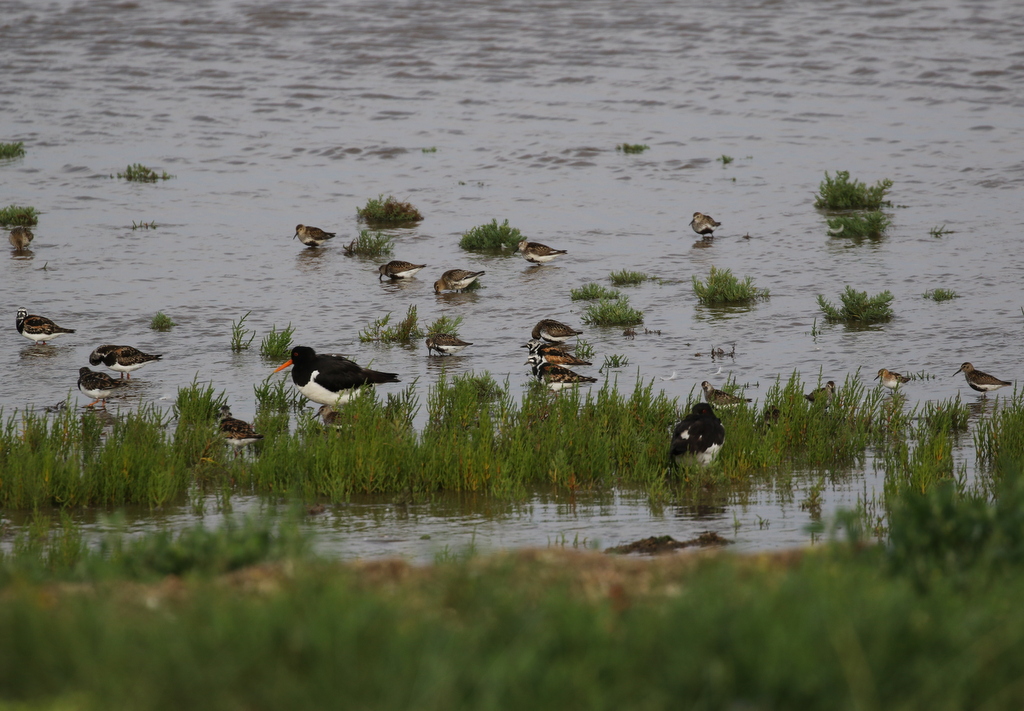 Spot the Little Stint – with Oystercatcher, Turnstone and Dunlin
Spot the Little Stint – with Oystercatcher, Turnstone and Dunlin
A steady stream of smaller waders were taking advantage of the last of the mud to feed along the near edge below the seawall. There were lots of black-bellied Dunlin, together with a selection of Turnstone, Sanderling and Ringed Plover. A Grey Plover put in a brief appearance with them too. A tiny Little Stint appeared with them, lingering on the mud just long enough for us to get the scope on it and everyone to get a good look. A moulting adult Curlew Sandpiper, its rusty red underparts now spotted with white, dropped in briefly on the other side of the channel.
The tide was coming in fast now, pushing all the waders ahead of it, so we moved further up along the seawall and stopped for another scan. The large mass of waders further out on the mud was being pushed further and further in too. The Oystercatchers were walking, like an amorphous blob flowing across the mud, but some of the Knot would periodically fly up and round, before landing again further in.
 Knot – whirling round before landed on the mud further up
Knot – whirling round before landed on the mud further up
The Redshank gave up the battle early, flying off the Wash and onto the pits to roost. They streamed past in groups and a loud ‘tchweet’ call alerted us to a Spotted Redshank flying in with them. A large number of the Dunlin flew in to the pits too. There were lots of godwits further out on the mud but a lone Bar-tailed Godwit appeared on the near edge, stopping to bathe in a small pool, and a Black-tailed Godwit was nearby on the edge of the main channel.
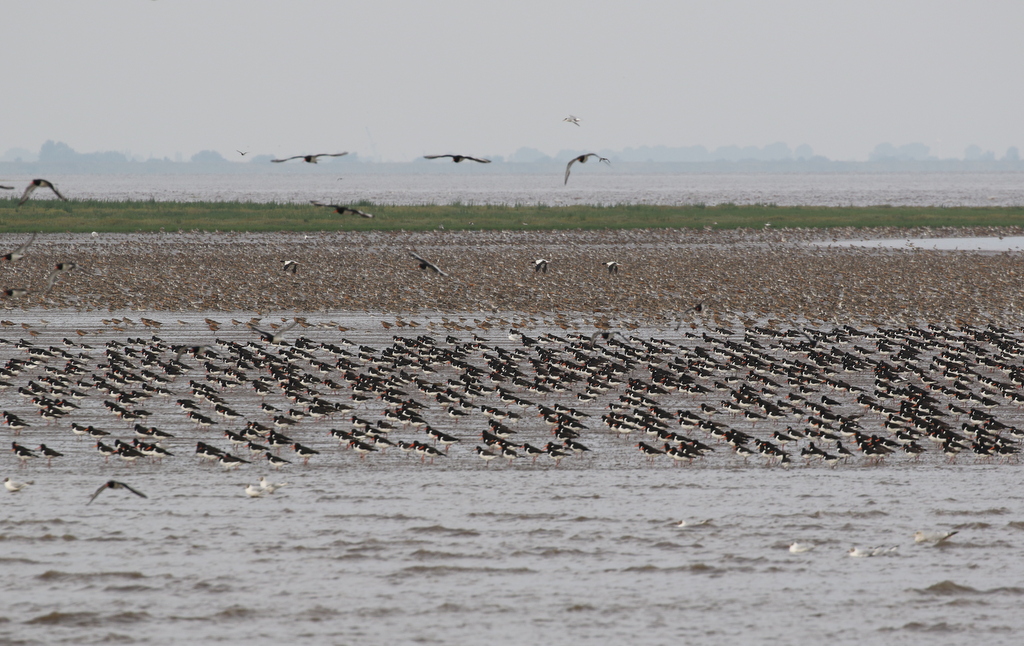 Waders – progressively concentrated onto the remaining corner of mud
Waders – progressively concentrated onto the remaining corner of mud
The Oystercatchers, Knot, godwits and Curlews were progressively concentrated into the last corner of exposed mud, tens of thousands of waders packed in shoulder to shoulder. The Oystercatchers threw in the towel first, peeling off in lines and flying in past us, calling noisily.
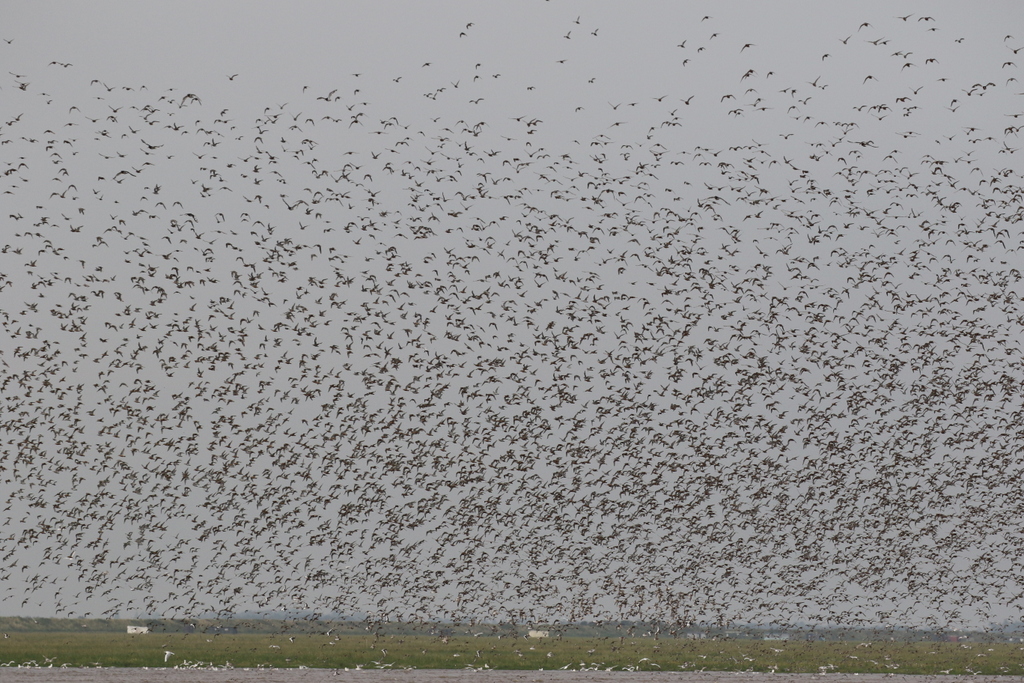 Knot – erupting from the Wash as the last mud is covered with water
Knot – erupting from the Wash as the last mud is covered with water
The Knot waited until the last moment, until it almost seemed like they wouldn’t come in at all, but we could see they were up to their bellies in the water. There was no exposed mud left for them. Finally they erupted into thick clouds and flew towards us in waves. As the first wave came in, as we could hear the beating of thousands upon thousands of wings coming over us, a mobile phone started to ring noisily nearby and drowned out the sound, annoying. Thankfully a second wave came in shortly after and we got to appreciate the full experience, looking up at all the birds as they flew low overhead, listening to the whirring of wings.
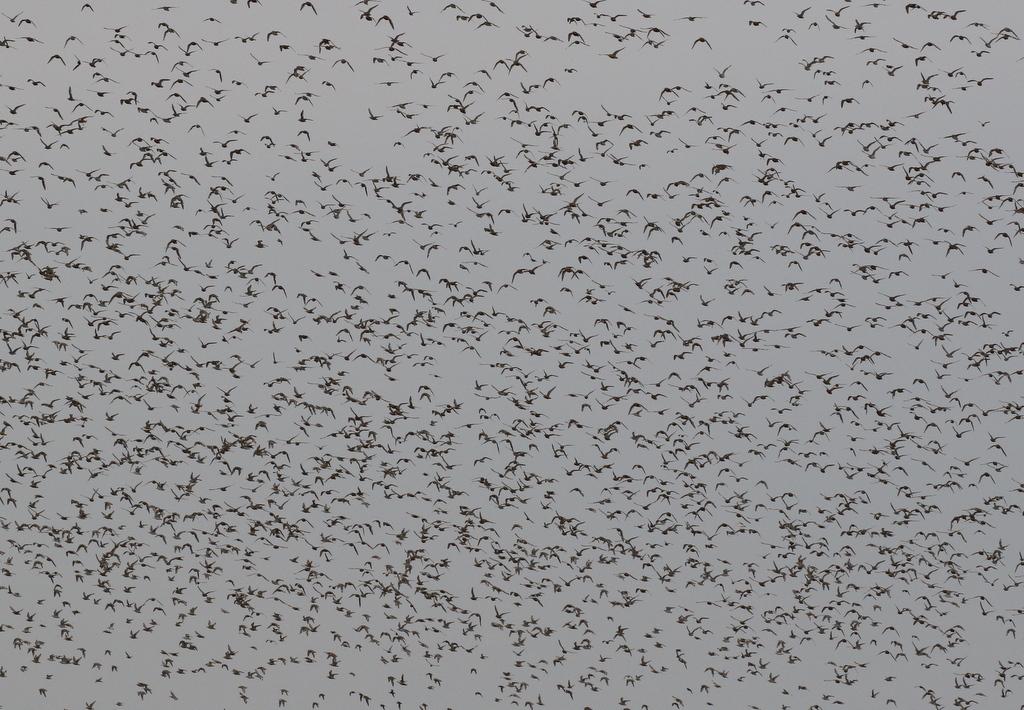 Knot – thousands came flying in over our heads in vast flocks
Knot – thousands came flying in over our heads in vast flocks
We turned to watch the flocks of Knot starting to drop down into the pits behind us. While lines of them streamed down, thousands circled over nervously, waiting their turn. There didn’t seem to be enough room for all of them today, as a couple of large flocks circled back out over the Wash.
As the sky cleared of birds, we made our way over to Shore Hide. The water level on the pits is rather high at moment, so the islands are smaller than they often are. A couple of them were completely coated in waders, mainly Knot, the ones around the edge pushed into the edge of the water. A lot of the Knot are still in their bright orange summer plumage at the moment, but others are already in grey winter plumage.
 Knot – packed in tightly onto the islands on the pits
Knot – packed in tightly onto the islands on the pits
Looking more closely, it was possible to see other birds in with them. A single Avocet and one Oystercatcher stood above the hordes but looked trapped, surrounded. There were several Common Terns in there too, surprisingly hard to see in the throng. The black bellies of the smaller Dunlin stood out, particularly as they gathered around the edges.
As the mass of waders on the island shuffled and shifted, a Curlew Sandpiper appeared close to the edge briefly, with the Dunlin. We had a good look at it in the scope before in shuffled back into the throng of Knot behind. A Little Stint was playing hard to spot until a Moorhen spooked the waders on the island and several of them flew round. The Little Stint appeared right on the front of the island, but was still hard to see, running in and out of the legs of the roosting Knot.
 Curlew Sandpiper – spot the odd one out, in with the Knot and Dunlin
Curlew Sandpiper – spot the odd one out, in with the Knot and Dunlin
The waders tend to largely sort themselves by species or relatives on the pits when they roost. The Oystercatchers were gathered mostly to the south of us on the bank of the pit. There were not so many godwits on here today – they had possibly gone on to the fields to roost instead.
There were some large groups of Redshank over by the far bank and other out in the middle. We took a closer look at the latter and found it was actually a mixture of Common and Spotted Redshanks. There were at least 17 Spotted Redshanks in the flock, mostly asleep. They were all adults and had to a greater or lesser degree moulted out of summer plumage – some had their black underparts extensively flecked with white now, but others were already predominantly in silvery grey winter plumage.
 Spotted Redshanks – four of the seventeen, with three Common Redshanks
Spotted Redshanks – four of the seventeen, with three Common Redshanks
There were lots of geese around the far bank, Greylags and Egyptian Geese. Looking across, we could see two smaller birds running around on the grass between them, two Common Sandpipers. A lone Tufted Duck was diving out in the middle of the water.
Round at the viewing screen at the south ends of the pit, we found yet more small waders packed tightly onto the islands, more Dunlin here and slightly fewer Knot. There were just a few Dunlin sleeping along the water’s edge to the left of the hide, and another Little Stint was with them. Out in the open, we got great views of it through the scope as it ran up and down, feeding actively.
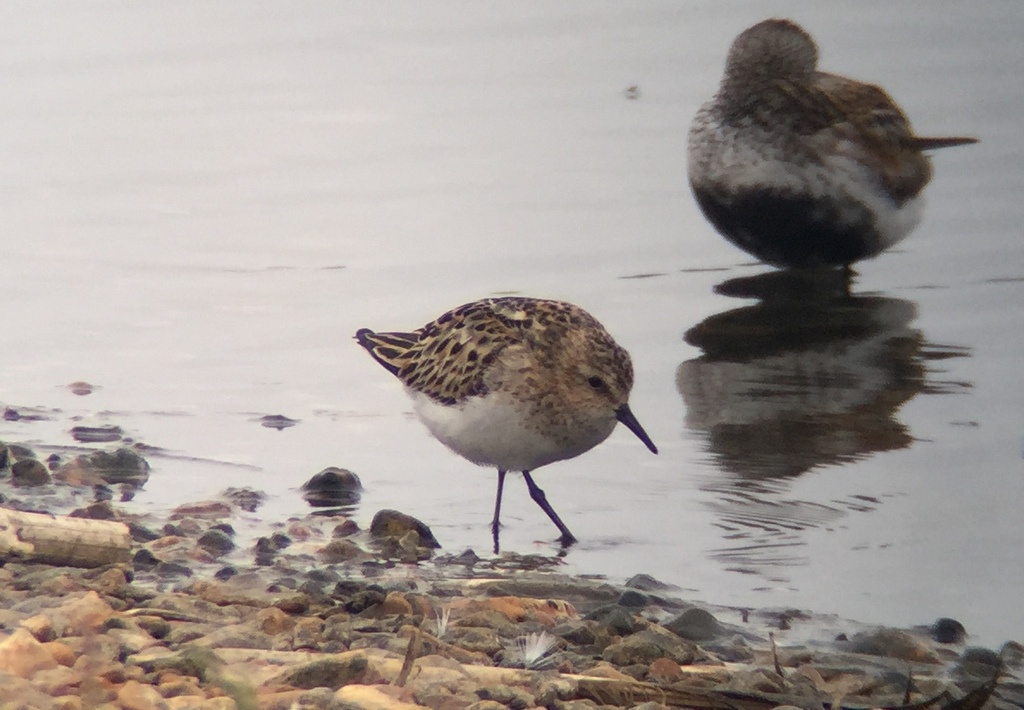 Little Stint – great views from at the south end of the pits
Little Stint – great views from at the south end of the pits
We turned our attention to the Dunlin and we were just checking through them to see if there was something more interesting hiding in with them when they started to shuffle and then all started to take off. A Moorhen ran right across the middle of the island, and spooked all the waders. Everything flew off. A few started to drift back in, landing on some of the other islands or the edge of the pit further back, but most headed back out towards the Wash.
The Knot back in front of Shore Hide were showing no signs of shifting, but we headed back out to the edge Wash anyway. The tide was already retreating fast and quite a bit of mud had been exposed. There were already quite a few Knot and other waders out on the Wash, but they were already quite distant. A couple of seals zipped past in the muddy channel at the front, carried out by the fast flowing water. A young Marsh Harrier was quartering the saltmarsh beyond.
There were lots of gulls and terns out on the mud too. We were just looking through them when a local birder came over and kindly alerted us to a Black Tern which was in with them. We were very thankful he did, as the Black Tern was completely hidden behind a couple of Common Terns at that stage. Eventually it shuffled forwards and we could see it properly – it was a moulting adult, still largely black but with extensive white feathering around the face.
Some small groups of Dunlin started to fly across from the pits and low out across the mud, but there was no sign of the rest of the Knot moving. It started to spit with rain so we decided to head back to the car. On the way, someone pointed out two Little Stints not far out on the mud, which we stopped to look at briefly. Hard to tell whether these were the birds we saw on the pits or different ones. As we walked along the path, several small groups of Common Swift flew low overhead, on their way south already. It felt like Summer was over already.
The rest of the day was to be spent round at Titchwell. We still had an hour or so before lunch when we got there, so we decided to have a quick look at Patsy’s Reedbed. The feeders by the visitor centre added a few common species to the list for the day – Greenfinch, Chaffinch, Blue Tit and Great Tit. A juvenile Robin was picking around for crumbs under the picnic tables.
At this time of year the male ducks are all in dull eclipse plumage, moulting. We picked out a few Shoveler and Gadwall amongst the Mallard. A couple of Common Pochard were diving out on the water. There were several Little Grebes scattered around the pool and a single stripy-headed juvenile Great Crested Grebe too. A Sedge Warbler zipped back and forth low over the water between the clumps of reeds and a Reed Warbler was flycatching from the bottom of the bulrushes down at the front.
A juvenile Marsh Harrier circled up over the reedbed behind, dark chocolate brown with a pale golden head. There were lots of hirundines hawking for insects over the reeds and swooping low over the water, mainly House Martins but with a few Sand Martins in with them. Then it was lunch time, so we headed back to the picnic area.
 Marsh Harrier – a juvenile circled over the reedbed
Marsh Harrier – a juvenile circled over the reedbed
After lunch, we headed out onto the reserve. It was cool and windy now, and spitting with rain. We could hear Bearded Tits calling from the reeds, but all we saw was a quick shape skim over the tops and drop in out of view. We headed for the shelter of Island Hide.
There were lots of Ruff feeding on the mud in front of the hide. They have returned from their tundra breeding grounds and are already moulting rapidly to winter plumage. Some still have lots of brightly coloured feathers but others have more scattered summer feathers remaining and are getting increasingly grey brown. Needless to say, it is a confusing mix for the unwary, particularly with an increasing number of smaller females coming back too now.
 Ruff – moulting rapidly to winter plumage now
Ruff – moulting rapidly to winter plumage now
There were a few Black-tailed Godwits in front of the hide too and more further back in the deeper water. A single Bar-tailed Godwit was still on the freshmarsh – a smart summer male, with deep rusty underparts continuing right down under the tail. With the tide out now, the other Bar-tailed Godwits would be out on the beach.
There is no shortage of Avocets here at the moment, with the breeding birds and brown-backed juveniles joined by more birds which have gathered here to moult. Several were feeding in front of the hide, giving us a chance to watch their distinctive feeding action, sweeping their bills from side to side through the top of the mud.
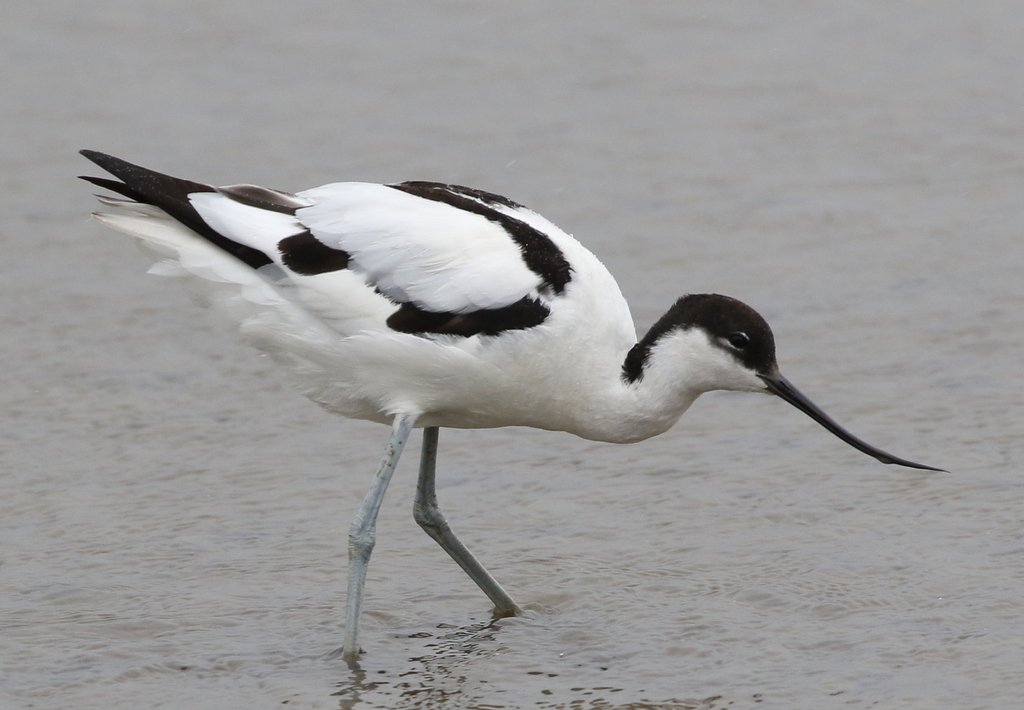 Avocet – feeding in front of Island Hide
Avocet – feeding in front of Island Hide
There were fewer other waders on here today. Perhaps some were out on the beach too, but it felt like a few had moved on overnight. There were a few Spotted Redshanks and we got a better look at them here compared to at Snettisham. They were feeding actively here, so we could see their distinctive needle-fine bills, longer than a Common Redshank’s. A small group of Golden Plover were on one of the islands over towards Parrinder Hide, still bearing their black summer bellies.
 Spotted Redshank – showing off its needle-fine bill
Spotted Redshank – showing off its needle-fine bill
There are lots of gulls on here at the moment, mostly Black-headed Gulls, adults and recently fledged juveniles. We could see a couple of Mediterranean Gulls over the far side too, and got an adult in the scope. It had already moulted largely to winter plumage, with a mostly white head with black bandit mask, but still sporting a heavier, brighter red bill than the Black-headed Gulls and pure white wing tips. A Little Gull appeared too, looking very small next to a Black-headed Gull. It was a young one, a first summer – there have been a few hanging around here for several weeks now.
When we heard Bearded Tits calling, we looked across to the reedbed to see a single bird fly in and land in the top of the reeds right on the edge. It dropped down and we could see it working its was along the bottom of the reeds at the start of the open mud. It disappeared deeper in, but the next time we looked over there were five Bearded Tits in the base of the reeds. They were all tawny brown juveniles. At one point they came right out onto the mud, where we could get a really good look at them.
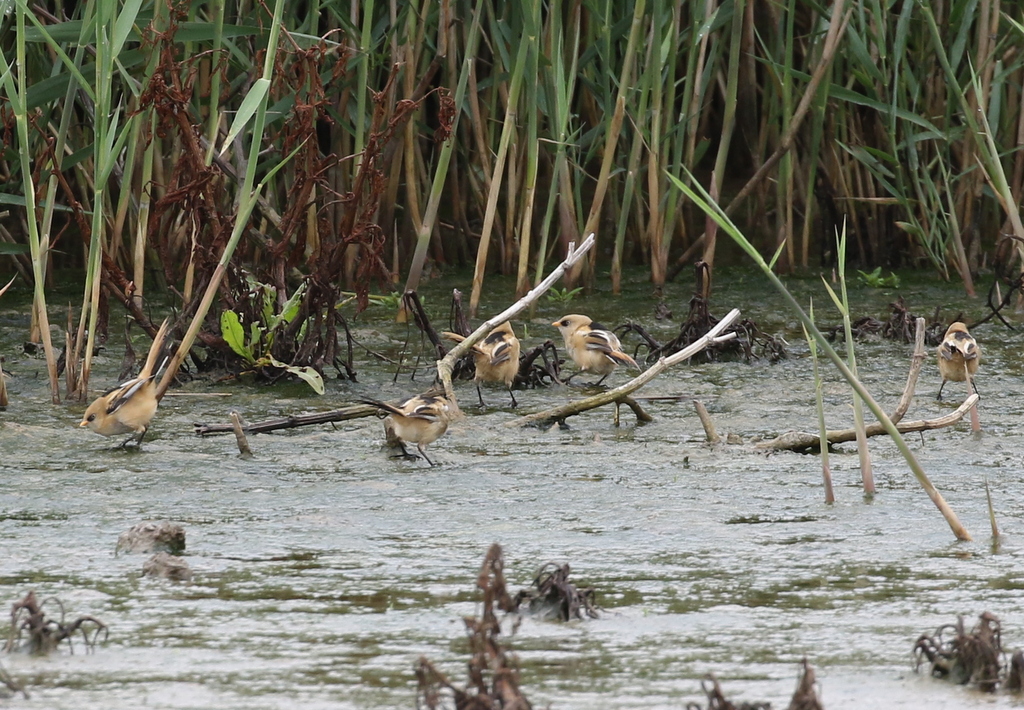
Round at Parrinder Hide, the birds were much the same as we had seen from Island Hide, but we got closer views of the gulls in particular. There were several more Mediterranean Gulls visible from this side, adults in different stages of moult, with white-speckled black heads and several juveniles, with scaly grey-brown upperparts. A second Little Gull, also a young 1st summer bird, had appeared on one of the islands, this one with much more obvious black feathers on its wings.
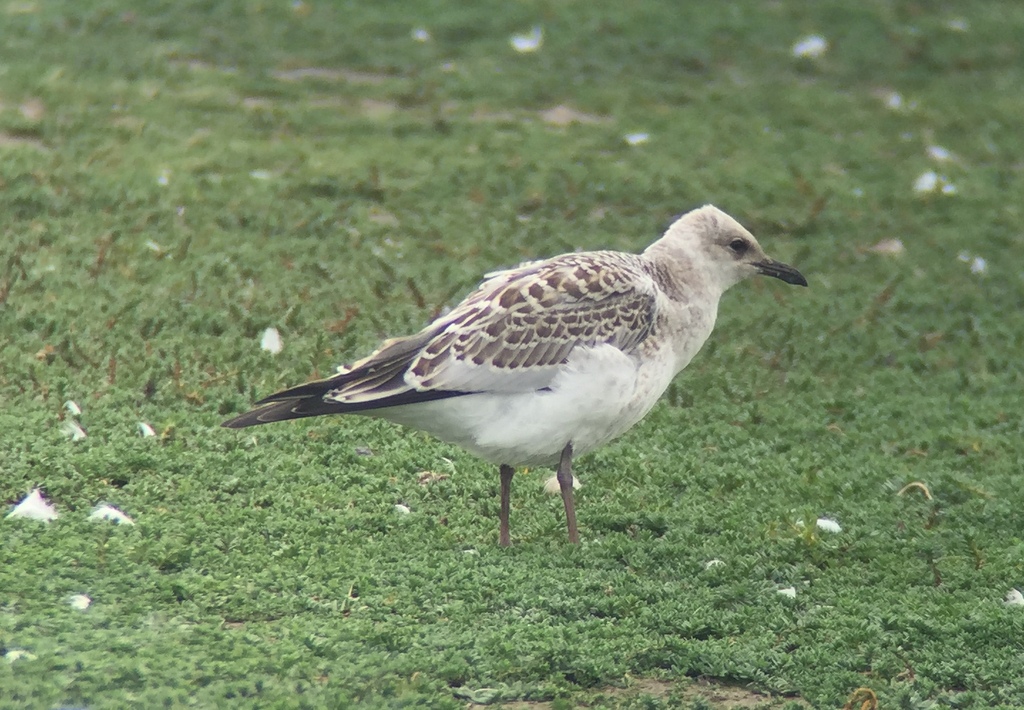 Mediterranean Gull – a scaly-backed juvenile
Mediterranean Gull – a scaly-backed juvenile
A lone Knot had dropped in onto the freshmarsh now, still in orange summer plumage. It was a bit of a contrast to see it on its own here, after seeing tens of thousands of Knot in vast flocks at Snettisham earlier. A single Common Snipe was the only addition to the day’s list here, feeding in amongst the vegetated islands out to the left of the hide.
There was some darker cloud some distance away over the ridge, but it was a bit brighter at the moment, so we made a quick dash out to the beach. The tide was out but there were quite a few people walking around over the mussel beds which meant there were not many waders feeding out here today. There were quite a few more Bar-tailed Godwits, as predicted, and Oystercatchers, but nothing else of note. The sea was quite calm and their were lots of Sandwich Terns flying back and forth offshore.
On the way back from the beach, we could see five large white shapes out on the saltmarsh, in the distance out towards Thornham Harbour. Through the scope we could see they were Spoonbills – not the best view at that range though. One did take off and fly towards us, but only got halfway across the saltmarsh before dropping down again behind the concrete bunker, presumably to feed in one of the muddy channels.
Back at the freshmarsh, we stopped to admire a Spotted Redshank which was feeding close to the path now. One of the Little Gulls was also on one of the muddy islands just below the bank. It had stopped to preen but was disturbed by a Moorhen which walked towards it – it seemed to be a bit of a theme today!
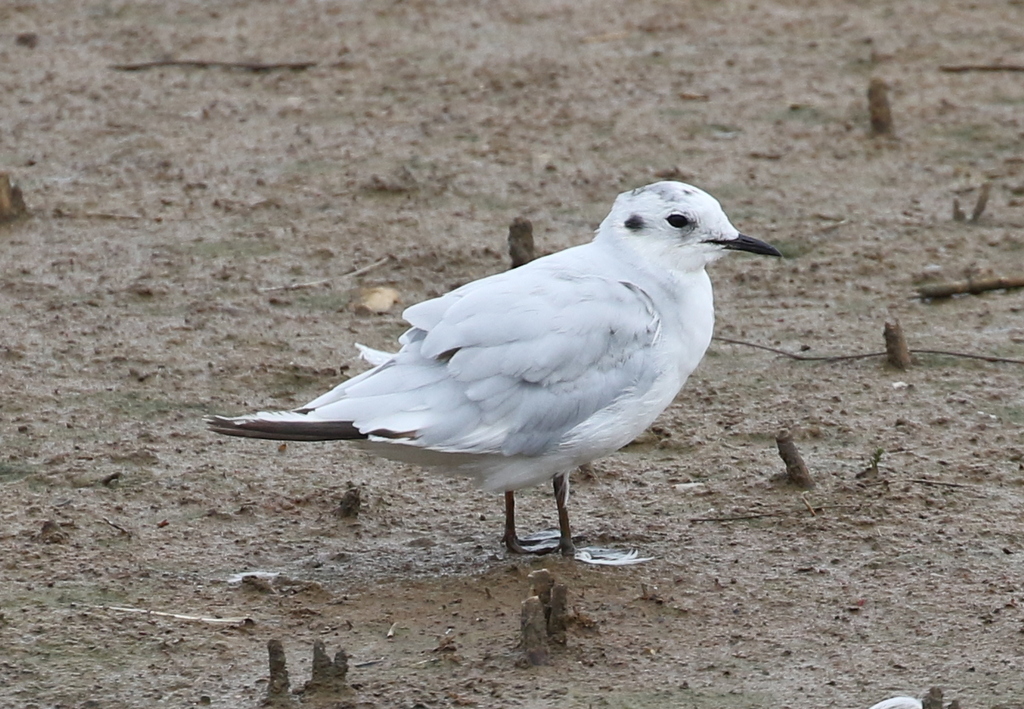 Little Gull – a 1st summer on the freshmarsh
Little Gull – a 1st summer on the freshmarsh
It had been an early start and it was now time to head back to the car. There were still a few last birds to add to the list for the day though. As we drove round and out of the car park, a Bullfinch flew across in front of us and disappeared into the bushes the other side. A Song Thrush flicked up from the corner and perched in a small elder tree. Then it was time to head for home.
















